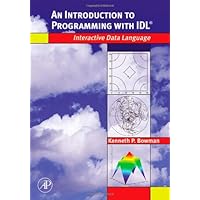
Average Reviews:

(More customer reviews)Nothing is more intimidating to a new user of IDL than to sit down at a computer with an empty command line prompt and a stack of manuals on their desk and be told to write an IDL program. Where to begin!? And the experience is especially frightening to a new user with little or no programming experience in any language, let alone IDL.
Ken Bowman has written an IDL book specifically for this user. It is intended as an introductory computer programming course for the research user with little or no training in any computer language, and it evolved from notes Ken uses in his own undergraduate IDL programming courses. It is meant to get the new IDL user analyzing and plotting data as soon as possible.
It is a narrow path he treads, because it is just as easy to offer too much detail as it is to offer too little information to the beginning user. Ken, for the most part, gets it exactly right in covering a broad selection of topics. I quibble with just two chapters. He sweeps aside the complexity of PostScript output by offering the new user two utility programs he fails to explain in the text, and his theoretical explanation of the FFT function left me gasping for breath and lamenting I hadn't paid closer attention in those long-ago math classes.
This is a book that will get you started, but probably won't answer all your questions when you turn your attention to more difficult research problems. Ken doesn't pretend it is anything other than what it is, however, and provides generous and helpful suggestions for where you can find additional information as you become ready for it. Readers already familiar with another programming language will appreciate this introduction to IDL, but might become frustrated with the slower pace and lack of specific detail on many topics.
The book has an associated web page, where you can find, among other things, the source code for all the programs mentioned in the book. Pay particular attention to the Errata section, especially if you are interested in structures in IDL. A printer glitch removed all the curly brackets from Ken's IDL code in the structure chapter and none of the examples will work as written in the book. A software problem, no doubt. (The example programs for the chapter are correct.) It serves as a reminder to me of how complex a topic software programming can be. This friendly book will be a welcome introduction to the subject for many a potential IDL programmer.
Click Here to see more reviews about: An Introduction to Programming with IDL: Interactive Data Language
In today's information age, scientists and engineers must quickly and efficiently analyze extremely large sets of data. One of the best tools to accomplish this is Interactive Data Language (IDLÂ), a programming and visualization environment that facilitates numerical modeling, data analysis, and image processing.IDL's high-level language and powerful graphics capabilities allow users to write more flexible programs much faster than is possible with other programming languages.An Introduction to Programming with IDL enables students new to programming, as well as those with experience in other programming languages, to rapidly harness IDL's capabilities: fast, interactive performance; array syntax; dynamic data typing; and built-in graphics. Each concept is illustrated with sample code, including many complete short programs. ÂMargin notes throughout the text quickly point readers to the relevant sections of IDL manualsÂEnd-of-chapter summaries and exercises help reinforce learningÂStudents who purchase the book are eligible for a substantial discount on a student version of the IDL software

No comments:
Post a Comment